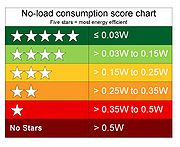
No load power
Encyclopedia
No load power consumption is the electric power consumed by a power charger
when it is plugged into a wall socket but without the mobile phone
or other handheld device being connected.
This wasted power is often incorrectly labeled as standby power
, which actually refers to the power consumed by a power adapter when a device such as a TV, DVD recorder
or audio system is in a lower power mode that cannot be switched off (or influenced) by the user. The power consumed in standby mode is used to maintain essential system functions such as remote control operation
or a digital clock
. Whereas the no-load energy consumed in a power charger is of no practical use.
As a result mobile phone manufacturers have become increasingly focused on reducing the no-load consumption of their power chargers. For example in 2002, a typical design might use about 3 watts on average and in 2007 less than 0.5 watts ,.
, the EU code of conduct on standby and other mandatory and regulatory standards are encouraging manufacturers to make further reductions in no-load energy demands.
For example: under the Energy Star V2.0 (level V) voluntary standard introduced in November 2008 the no-load consumption of a typical 4.25 W charger has to be less than 300 mW (0.3 watts). The EU code of conduct version 4, introduced in January 2009 has a limit of 0.25W for mobile handheld battery driven applications, reducing to 0.15W in January 2011. Complete list of national and international standards.
 In November 2008, the world’s five largest mobile phone makers – Nokia, Samsung, LG Electronics, Motorola and Sony-Ericcson - announced their own five star energy rating system to help consumers more easily identify the most energy-efficient chargers. Chargers are being labeled with no stars for no-load consumptions > 0.5 W and up to five stars for consumptions less than ≤0.03W (30mW).
In November 2008, the world’s five largest mobile phone makers – Nokia, Samsung, LG Electronics, Motorola and Sony-Ericcson - announced their own five star energy rating system to help consumers more easily identify the most energy-efficient chargers. Chargers are being labeled with no stars for no-load consumptions > 0.5 W and up to five stars for consumptions less than ≤0.03W (30mW).
Battery charger
A battery charger is a device used to put energy into a secondary cell or rechargeable battery by forcing an electric current through it.The charge current depends upon the technology and capacity of the battery being charged...
when it is plugged into a wall socket but without the mobile phone
Mobile phone
A mobile phone is a device which can make and receive telephone calls over a radio link whilst moving around a wide geographic area. It does so by connecting to a cellular network provided by a mobile network operator...
or other handheld device being connected.
This wasted power is often incorrectly labeled as standby power
Standby power
Standby power, also called vampire power, vampire draw, phantom load, or leaking electricity , refers to the electric power consumed by electronic and electrical appliances while they are switched off Standby power, also called vampire power, vampire draw, phantom load, or leaking electricity...
, which actually refers to the power consumed by a power adapter when a device such as a TV, DVD recorder
DVD recorder
A DVD recorder , is an optical disc recorder that uses Optical disc recording technologies to digitally record analog signal or digital signals onto blank writable DVD media...
or audio system is in a lower power mode that cannot be switched off (or influenced) by the user. The power consumed in standby mode is used to maintain essential system functions such as remote control operation
Remote control
A remote control is a component of an electronics device, most commonly a television set, used for operating the television device wirelessly from a short line-of-sight distance.The remote control is usually contracted to remote...
or a digital clock
Digital clock
A digital clock is a type of clock that displays the time digitally, i.e. in cyphers, as opposed to an analog clock, where the time is displayed by hands. Digital clocks are often associated with electronic drives, but the "digital" description refers only to the display, not to the drive mechanism...
. Whereas the no-load energy consumed in a power charger is of no practical use.
Consequences
The no-load power contribution to a country’s household energy demands is thought to be considerable . The average number of handsets per capita is frequently more than one in many countries http://www.nationmaster.com/graph/med_tel_mob_cel_percap-telephones-mobile-cellular-per-capita, the proportion of chargers left accidentally or deliberately plugged in is thought to be significant and with current designs over 60% of a mobile phone’s energy use is wasted as no-load http://www.nokia.com/environment/we-energise/how-you-can-save-energy/charger-energy-rating.As a result mobile phone manufacturers have become increasingly focused on reducing the no-load consumption of their power chargers. For example in 2002, a typical design might use about 3 watts on average and in 2007 less than 0.5 watts ,.
Policies to reduce no load power
Energy StarEnergy Star
Energy Star is an international standard for energy efficient consumer products originated in the United States of America. It was first created as a United States government program during the early 1990s, but Australia, Canada, Japan, New Zealand, Taiwan and the European Union have also adopted...
, the EU code of conduct on standby and other mandatory and regulatory standards are encouraging manufacturers to make further reductions in no-load energy demands.
For example: under the Energy Star V2.0 (level V) voluntary standard introduced in November 2008 the no-load consumption of a typical 4.25 W charger has to be less than 300 mW (0.3 watts). The EU code of conduct version 4, introduced in January 2009 has a limit of 0.25W for mobile handheld battery driven applications, reducing to 0.15W in January 2011. Complete list of national and international standards.
5 star rating system


